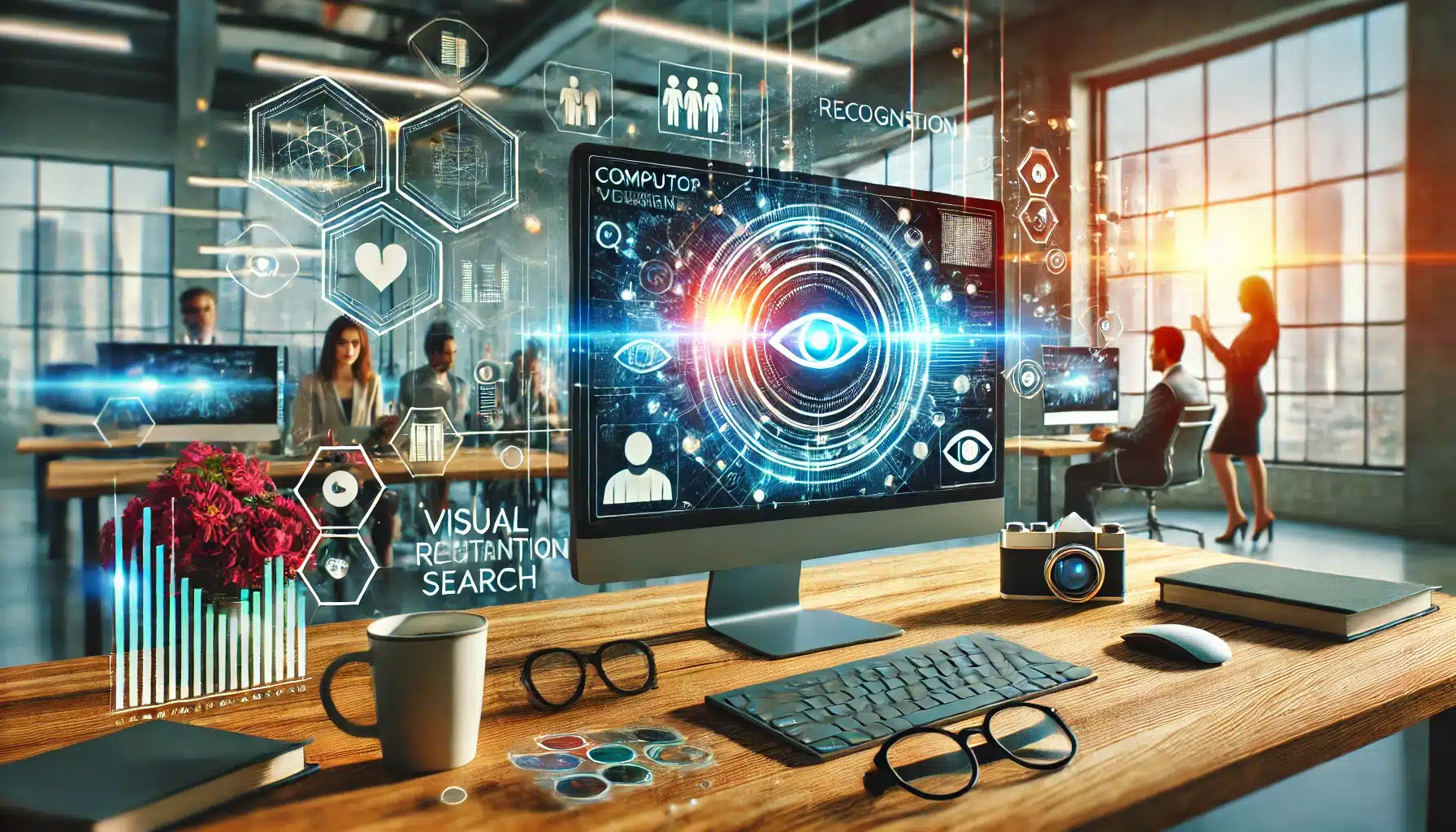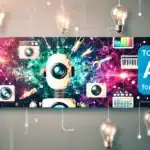Introduction:
Picture this: Sarah, a creative director at a trendy marketing agency, is scrolling through her Instagram feed. She pauses on a stunning image of a cozy living room, tapping on various items to instantly find out where she can buy them. Later, she uses her phone’s camera to virtually place a new couch in her own living space, seeing how it fits before making a purchase. Welcome to the brave new world of visual content marketing, powered by computer vision and artificial intelligence.
In this blog post, we’re diving deep into the transformative impact of computer vision on visual content marketing. We’ll explore how this cutting-edge technology is reshaping the way brands create, share, and monetize visual content. From image recognition to visual search and augmented reality, we’re about to embark on a journey that will change the way you see marketing – quite literally. So, grab your VR goggles (just kidding, your imagination will do), and let’s dive into the visually stunning future of marketing that’s already here.
The Evolution of Visual Content Marketing: From Static Images to Interactive Experiences
Before we leap into the AI-powered present, let’s take a quick stroll down memory lane. Remember when visual content marketing looked like this?
1. Stock photos plastered across websites
2. Flashy banner ads (often more annoying than engaging)
3. Basic product photos in e-commerce listings
4. Billboards and print ads (yes, those still exist!)
While these traditional forms of visual marketing still have their place, the landscape has evolved dramatically. Enter computer vision – the game-changing technology that’s turning static visuals into interactive, shoppable, and deeply engaging experiences.
Computer Vision: The Eyes of AI
So, what exactly is computer vision? At its core, computer vision is a field of artificial intelligence that trains computers to interpret and understand the visual world. It’s like giving a computer a pair of eyes and a brain to make sense of what it sees.
Key Components of Computer Vision in Marketing:
1. Image Recognition: The ability to identify objects, people, text, and scenes within images.
2. Visual Search: Allowing users to search using images instead of text.
3. Augmented Reality (AR): Overlaying digital information onto the real world through a camera view.
Now, let’s dive into how these technologies are transforming visual content marketing.
1. Image Recognition: Making Every Picture Worth a Thousand Data Points
Image recognition is the foundation of computer vision in marketing. It’s revolutionizing how brands understand and leverage visual content.
Applications in Marketing:
a) User-Generated Content (UGC) Analysis
Brands can automatically identify their products in social media posts, even when they’re not explicitly tagged. This allows for better tracking of brand mentions and sentiment analysis.
Case Study: Unilever’s Visual Listening
Unilever used image recognition to analyze millions of social media images featuring their products. This helped them understand how consumers were using their products in real life, informing future marketing and product development decisions.
b) Visual SEO Optimization
Image recognition helps optimize visual content for search engines by automatically generating relevant alt text and metadata.
c) Content Moderation
AI can quickly scan and flag inappropriate or off-brand images, ensuring brand safety across visual campaigns.
2. Visual Search: When a Picture is Worth a Thousand Keywords
Visual search is changing the way consumers discover and shop for products online.
How It Works:
1. A user uploads an image or points their camera at an object
2. The visual search engine analyzes the image using computer vision
3. The engine returns visually similar images or product listings
Impact on Marketing:
a) Shoppable Content
Brands can make their visual content instantly shoppable. See something you like in a brand’s Instagram post? Just tap to buy.
b) Enhanced Product Discovery
Users can find products even when they don’t know the right keywords to describe them.
Example: Pinterest Lens
Pinterest’s visual search tool allows users to take a photo of an item and find visually similar products on the platform. This has opened up new avenues for product discovery and inspiration.
c) Improved User Experience
Visual search reduces friction in the customer journey, making it easier for consumers to find and purchase products they’re interested in.
3. Augmented Reality: Blending the Digital and Physical Worlds
AR is perhaps the most exciting frontier in visual content marketing, offering immersive and interactive experiences.
Applications in Marketing:
a) Virtual Try-On
From makeup to eyewear to furniture, AR allows consumers to see how products look in their own environment before purchasing.
Success Story: IKEA Place
IKEA’s AR app lets users virtually place furniture in their homes, dramatically reducing returns and increasing customer satisfaction.
b) Interactive Packaging
AR can turn product packaging into an interactive experience, offering additional information, games, or exclusive content when scanned with a smartphone.
c) Immersive Brand Experiences
Brands can create AR-powered experiences that engage consumers in unique and memorable ways.
Example: Pepsi’s Bus Shelter AR Campaign
Pepsi created an AR experience that appeared to transform a London bus shelter, showing tigers, robots, and UFOs on the street. This campaign generated significant buzz and engagement.
The AI-Powered Visual Marketing Toolkit
Now that we understand the core technologies, let’s explore some AI-powered tools and techniques reshaping visual content marketing:
1. AI-Generated Images and Videos
Tools like DALL-E 2 and Midjourney can create stunning, original visuals based on text prompts. This opens up new possibilities for creating unique marketing visuals at scale.
2. Automated Video Creation
AI tools can automatically create short-form videos from existing content, making it easier for brands to produce video content for platforms like TikTok and Instagram Reels.
3. Visual A/B Testing
AI can analyze which visual elements (colors, layouts, subjects) perform best in marketing materials, allowing for data-driven design decisions.
4. Personalized Visual Experiences
AI can tailor visual content to individual users based on their preferences and behavior, creating more engaging and relevant experiences.
5. Real-Time Visual Analytics
AI-powered tools can provide instant insights on how users are interacting with visual content, allowing for rapid optimization.
The Human Touch in an AI-Powered Visual World
With all this talk of AI and computer vision, you might be wondering: Is there still a place for human creativity in visual marketing? Absolutely! In fact, the human element is more crucial than ever. Here’s why:
1. Creative Strategy
While AI can generate and optimize visuals, it takes human insight to develop overarching creative strategies that align with brand values and marketing goals.
2. Emotional Resonance
Humans are still best at creating visuals that evoke deep emotional responses and forge meaningful connections with audiences.
3. Ethical Considerations
Human oversight is crucial to ensure that AI-generated visuals and AR experiences are used ethically and responsibly.
4. Cultural Sensitivity
Humans are needed to ensure that visual content is culturally appropriate and resonates across diverse audiences.
5. Artistic Direction
While AI can generate visuals, human artists and designers are essential for providing artistic direction and maintaining brand aesthetic.
Implementing Computer Vision in Your Visual Marketing Strategy: A Step-by-Step Guide
Ready to embrace the computer vision revolution in your visual marketing? Here’s a step-by-step guide to get you started:
1. Audit Your Current Visual Content
Assess your existing visual assets and identify areas where computer vision could add value.
2. Set Clear Objectives
Define what you want to achieve with computer vision (e.g., increase engagement, boost conversions, improve user experience).
3. Choose the Right Technologies
Decide which aspects of computer vision (image recognition, visual search, AR) align best with your objectives.
4. Start with a Pilot Project
Begin with a small-scale implementation to test the waters and gather data.
5. Invest in the Right Tools
Research and invest in computer vision tools and platforms that fit your needs and budget.
6. Train Your Team
Ensure your marketing and design teams understand how to leverage computer vision technologies effectively.
7. Measure and Iterate
Continuously monitor the performance of your computer vision-powered campaigns and refine your approach based on the results.
The Future of Computer Vision in Visual Marketing
As we look to the future, the potential of computer vision in marketing is truly exciting. Here are some trends to watch:
1. Advanced Personalization
AI will enable even more personalized visual experiences, tailoring content to individual preferences and contexts.
2. Emotion Recognition
Computer vision may soon be able to recognize and respond to users’ emotional states, allowing for more empathetic marketing.
3. Holographic and 3D Experiences
As AR technology advances, we may see more immersive 3D and holographic marketing experiences.
4. Visual Conversation AI
Chatbots may evolve to include visual elements, allowing for more natural and intuitive interactions with brands.
5. Real-World Object Recognition
Advances in computer vision may allow for real-time recognition and information overlay on physical objects, blending digital and physical marketing seamlessly.
Ethical Considerations in Computer Vision Marketing
As with any powerful technology, the use of computer vision in marketing comes with ethical considerations:
1. Privacy Concerns
How do we balance personalization with respect for user privacy?
2. Transparency
Should brands disclose when computer vision technologies are being used in marketing campaigns?
3. Bias in AI
How do we ensure that computer vision algorithms don’t perpetuate or amplify existing biases?
4. Data Security
How can we protect the vast amount of visual data collected through these technologies?
5. Psychological Impact
What are the long-term effects of increasingly immersive and personalized visual experiences on consumers?
Conclusion: Embracing the Visual AI Revolution
As we wrap up our journey through the world of computer vision in visual content marketing, let’s return to Sarah, our creative director. She’s no longer just creating static images or standard videos. Instead, she’s orchestrating immersive, interactive visual experiences that engage consumers in ways previously thought impossible.
The rise of computer vision in marketing isn’t just a trend—it’s a revolution. It’s changing the way we create, share, and interact with visual content. By embracing AI-powered tools and techniques, we can create more engaging, personalized, and effective visual marketing campaigns.
However, it’s crucial to remember that technology is a tool, not a replacement for human creativity and strategy. The most successful visual marketing strategies will be those that find the right balance between AI capabilities and human insight.
As we move forward, the question for marketers isn’t whether to use computer vision, but how to use it effectively and ethically. By embracing this technology and approaching it thoughtfully, we can unlock new levels of creativity and engagement in our visual marketing efforts.
So, are you ready to join the computer vision revolution in marketing? Whether you’re a seasoned creative professional or just starting out, the world of AI-powered visual content offers endless possibilities. It’s time to explore, experiment, and discover how this powerful technology can transform your marketing strategy.
Remember, the goal isn’t to replace human creativity, but to enhance it. By leveraging computer vision in your visual marketing, you’re not just keeping up with the times—you’re positioning yourself at the forefront of a new era in digital communication.
So go ahead, take that first step. Explore image recognition tools, experiment with AR experiences, and see how computer vision can amplify your visual content. The future of marketing is here, and it’s more visual, more interactive, and more engaging than ever before. Are you ready to see it with new eyes?


